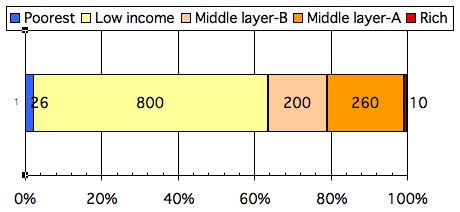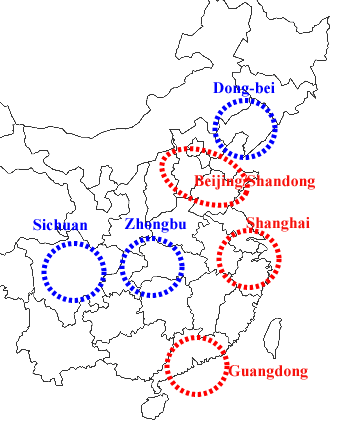Whereabouts of
|
Cat: ECOPub: 2006#:0620a |
|
Zhu Jian-rong (朱建栄) |
06628u/18214r |
Title
Whereabouts of Chinese economic society
中国経済社会の行方
Author
Zhu Jian-rong
朱建栄
Published
2006
2006年
Index
Why?
- Brown bag seminar was held by Prof. Zhou. of Toyo Gakuen Univ.
at ADB (Asia Development Bank) in June, 2006. Audiences bring into
their lunches in brown paper bag to attend the session, which is
popular now in US intelligent circles.
- Prof. Zhu Jian-rong, Shanghai native, is one of famous commentators
of the latest Chinese political-economical situation. His comments
include several key concept to understand changing China, in the
context of China-US, and China-Japan relationship.
- He lives in Japan in about 20 years, is one of the cool-headed
observer of both countries. He disclosed that he found the most
impressive word in Japan: iridescent solution, which is
not a way of deliberately ambiguous solution, but also a really
Oriental wisdom of solution.
- 東洋学園大学教授の朱建築榮が、2006年6月にアジア開発銀行でのブラウン・バック・セミナーで講演した。ブラウン・バック・セミナーはランチを茶色の袋に入れて持ち込み、食べながら講演を聴く米国で流行の方式である。
- 上海出身の朱建栄教授は最新の中国政治経済について著名なコメンテータの一人である。そのコメントには変化しつつある中国、特に中米、日中関係の文脈において理解する上でのキー概念が含まれている。
- 彼は日本に20年も滞在しており、両国についてのクールな観察者である。曰く、日本で発見した最も印象的な言葉は「玉虫色の解決」であり、それは意図的で曖昧な解決方法のみならず、これこそが東洋的な智恵の解決である、と。
Tag
; East Asian Community Initiative; GDP-ism; Income
differentials; Income distribution; ; Six economic bloc; Third revolution; Three
agriculture problems;
Summary
要約
>Top
0. Preface:
- In 2006, at lunch time at the office of Asian Development Bank in downtown
Tokyo, about 50 businessmen gartered in knots, carrying brown paper
lunch bags. It was particularly hot day in June, but it held cool
presentation can-do Q&A about China today.
- That lunch meeting was the latest topic of 1.3 billion people's
economy. The lecturer emphasized that today is the age of Global,
Speed, and Market.
- I participated in the lecture with my crutches due to rupture
of Achilles tendon, which will be an unforgettable event for me.
0. 序:
- 2006年に、東京中心部のアジア開銀事務所での昼時、約50名のビジネスマンが、ランチの入った茶色の紙袋を抱えて三々五々集まってきた。その日は特に暑い6月の日だった。
- そのランチ・ミーティングは13億の民の経済についての最新トピックスであった。講師は、今日がグローバルとスピードとマーケットの時代であると強調していた。
- 私はアキレス腱を断裂して松葉杖で、この講演に参加した。このことは忘れられない思い出となろう。
>Top
1. The Third Revolution in China:
- Expansion of
Middle Class in China:
A kind of catastrophic change is happening in Chinese society.
- We should recognize the undercurrent of various social phenomena.
- Changes during the last two decades after Mao Tsu-tung age
are drastic. Until then, proletarian and agrarian classes with
intelligent stratum have deprived rights from landload and capitalist
classes.
- The third revolution Deng Xiaoping achieved:
- First revolution which accomplished political independence.
- Second revolution which accomplished economic self-subsistence.
- Third revolution which changes social structure (now in process)
- >Top Chinese Income distribution: Unit in million:
- 26M people: Poorest segment of the population
- 800M people: Low income class, mostly inland area
- 200M people: Middle class consciousness
- 260M people: Middle class (more than RMB 30,000)
- 10M people: People who became rich during last two decades,
living in 4 coastal areas; No succession duty at the moment, but
probably enacted within a couple of years.
- Once, 'House earning RMB10,000 annually' means a symbol of rich,
but now no more than poor!
- Lower labor cost is competitiveness:
- Continuous supple of labor power from rural area.
- Monthly salary of RMB 500-600 ($63- 75) is willingly acceptable.
But lower price level in the inland area should be considered.
- Economic growth rate: 9% in coastal provinces, while 5% in
inland area.
- Impact on economy and society by the increase of middle class:
It is important to watch about 500M middle class people, including
not really middle class but middle class consciousness.
- Most of the demonstrators in cities like Chong-qing are middle
class.
- Right of consumer: brand/design/ecology-conscious (antipollution
campaign in inland area)
- Right to know, Right to participate, Against corruption: 80K
cases annually occur.
- Such awareness of their rights looks like 'Nationalism.'
- In the latter 1990s, such nationalism points anti-US
- But after 9.11 in 2001, China-US ally against terrorism.
- Concurrently, Yasukuni shrine issue arose in China-Japan.
There is no anti-Japan sentiment from the beginning.
- Social rebellious phase: just like student movement in 1960s
in Japan.
- The awareness of rights may promote political democracy in middle
and long term.
- Excessive saving trend is true and due to lack of pension system.
- But this trend will be balanced to potential increase of consumption.
- Shift to big-scale consumer society:outgrow from industrial processing
region
- >Top From GDP supremacist to Human-conscious
policy (education, welfare, environment) (Capitalism=Ziben
zhuyi sounds homonymic to GDP-ism)
- Exchange appreciation of Yuen: probably occurs 2-3% annually,
partly responding to economic friction with US. But big appreciation
like 10% may not occur.
1.
第三の革命:
- <左図> 中国の中産階級の拡大:
- 中国で起きている地殻変動、社会構造変化:
- 個々の事象だけでなく、背後の流れを分析すべきである。
- 毛沢東以降の20年間大きく変化した。
- それまでは労・農階級+知識階層による地主・資産家の権利剥奪路線
- 邓小平の経済革命がもたらした第三の革命
- 政治的独立の第一革命
- 経済的自立の第二革命
- 社会構造変化の第三革命 (現在進行中)
- <下図> 中国の所得分布:
- 2600万人:極貧困層
- 8億人:低所得層
- 2億人:中間層(意識として)
- 2.6億人: 中間層 (年収3万元超)
- 1000万人: 過去20年に出現した富裕層で4つの沿海部に住む。現在、相続税ないが、2-3年以内に導入予定。
- かつては「万元戸」は金持ちの象徴、現在は貧困にすぎない。
- 安い人件費という競争力:
- 農村部からの常時人材供給力。
- 月500-600元でOK (RMB8=US$1)
- 内陸部の物価水準の低さを考慮すべき。
- 経済成長率: 沿岸部は年9%、内陸部は5%
- 中間層拡大による経済・社会への影響:
5億人の中間層 (まだ中間層ではないが中流意識の層を含む) の動向を注視することは重要である。
- 重慶などの都市でのデモの多くは中間層
- 消費者の権利: 分度、デザイン、環境重視
- 知る権利、参加する権利、腐敗反対。毎年8万件も発生している。
- これらの権利意識が、ナショナリズムの台頭へ
- 90年代後半のナショナリズムの矛先は反米
- 2001.9.11以降、中米は反テロで連携。
- 同時期に日中韓に靖国問題が発生。最初から反日ではなかった。
- 60年代の日本の学生運動のような、社会的反抗期と言える。
- 中長期的には政治の民主化促進
- 過剰な貯蓄傾向は事実であり、年金制度の不備が原因。
- この傾向は消費拡大でバランス:
- 加工型産業から大規模な消費社会へ:a
- G本主義 (GDP至上主義)から人本主義 (教育、福祉、環境重視)
(G本主義と資本主義Ziben zhuyiとは発音が近い)
- 人民元切り上げ問題: 対米貿易摩擦対応としておそらく年2-3%切り上げ。但し10%以上の切り上げはないだろう。

>Top 2. Current status & trend of Chinese
economy:
- Six major
economic bloc:

- Three major economic bloc:
- Beijing/Shandong area:
- Shanghai area:
- Huanan/Guangdong area:
- Additional three developing economic bloc:
- Dong-bei area
- Zhongbu/Jiangnan area
- Inland/Sichuan area:
- Impact of Beijing Olympic in 2008: affect only Beijing area.
- Economic policy of Hu Jintao administration:
- Building of new farm village:
- During last half century, cities developed at the expense
of farm village.
- From now on, farm villages will develop at the expense of
cities. (improvement of food production, farmers' income,
structure of rural areas)
- >Top Three
agriculture problems:
- low productivity of agriculture
- desolation of farm village
- poverty of farmers
- Countermeasure to three problems:
- production increase of food, increase of income
- Structural reform in farm village:
- Direct election of administration level: aiming self-management.
- Decease of population ratio of farmers, like advanced countries;
aiming to increase of effective population of competition (first
of all, from 60% to less than 30%)
- Effective utilization of land; inducing of agribusiness organization
(agripreneur?)
- 10th NPC (National People's Congress) and 11th 5-year-plan (Mar.
2006)
2.
中国経済の現状と行方:
- 六大経済圏:
- 三大経済圏:
- 北京・山東省地区
- 上海地区
- 華南・広東地区
- 次に発展している3経済圏:
- 胡錦涛政権の経済政策:
- 新農村建設:
- 過去50年は農村の犠牲において都市が発展
- これからは都市の犠牲において農村の発展を目指す。
- 三農問題解決目指す:
- 農業の低生産性、農村の荒廃、農民の貧困問題
- 三農問題対策:
- 更なる食糧増産、農民収入増加
- 農村の構造改革:
- 行政レベルの直接選挙:自己管理させる
- 農村人口比率減を先進国並みに;有効競争人口増加へ (まず60%を30%未満に)
- 土地の有効利用:農業の企業方式
- 第10回全人代と第11次5カ年計画(2006.3)
>Top Chinese income
differentials between rural area and city (Unit: Yuen
per capita (left) and ratio of city/rural (right)
- Source: Chinese national statistics 2004
>Top 3. Proposal to China-Japan
relationship:
- Establishment of long-term strategy of China-Japan relationship,
paying attention to the drastic change of Chinese economy.
- Communication channels with New new leaders (40's in age) in China.
- >Top Improvement of China-Japan relationship with Oriental style solution,
and promotion of East Asian Community Initiative.
3.
日中関係に関する提言:
- 中国社会の地殻変動の理解の上の長期戦略
- 中国のニュー・ニューリーダ(40代)とのパイプ構築
- 日中問題の東洋型の解決。東アジア共同体構想の促進
Comment
- Prof. Zhu Jian-rong's analysis looks practical and persuasive.
- Now we are urged to have more strategic and future-oriented thinking
as well as shared understanding of long historical relation.
- Anyway, we are the ethnic group who eat rice, use Kanji character,
and live under monsoon climate belonging to East Asia.
- 朱建栄氏の分析は現実的で説得力がある。
- 今や、我々は長い歴史的な関係の共通の理解と共に、さらに戦略的で未来志向が求められている。
- いずれにせよ我々はコメを食べ、漢字を使い、そしてモンスーン気候に生きる東アジアの民族なのである。
Title |
Whereabouts of Chinese economic society |
中国経済社会の行方 |
|---|---|---|
Author |
Zhu Jian-rong | 朱建栄 |
Published |
2006 |
2006年 |
Index |
||
Why? |
|
|
Tag |
; East Asian Community Initiative; GDP-ism; Income differentials; Income distribution; ; Six economic bloc; Third revolution; Three agriculture problems; | |
Summary |
要約 |
>Top 0. Preface:
|
0. 序:
|
>Top 1. The Third Revolution in China:
|
1. 第三の革命:
|
 |
|
>Top 2. Current status & trend of Chinese economy:
|
2. 中国経済の現状と行方:
|
>Top Chinese income
differentials between rural area and city (Unit: Yuen
per capita (left) and ratio of city/rural (right)
|
|
>Top 3. Proposal to China-Japan relationship:
|
3. 日中関係に関する提言:
|
Comment |
|
|